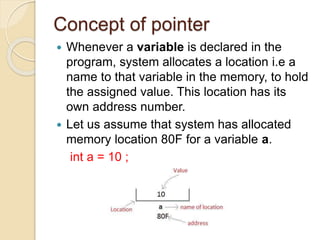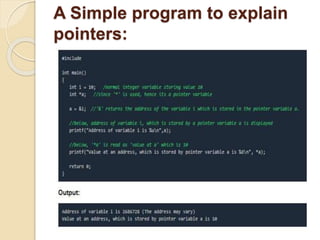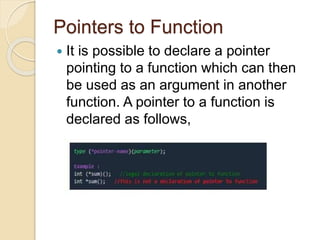Pointers in c language
- 2. Definition A Pointer is a variable that holds address of another variable of same data type. also known as locator or indicator that points to an address of a value.
- 3. Benefits of using pointers Pointer reduces the code and improves the performance, it is used to retrieving strings, trees etc. and used with arrays, structures and functions. We can return multiple values from function using pointer. It makes you able to access any memory location in the computer's memory. It allows C to support dynamic memory
- 4. Concept of pointer Whenever a variable is declared in the program, system allocates a location i.e a name to that variable in the memory, to hold the assigned value. This location has its own address number. Let us assume that system has allocated memory location 80F for a variable a. int a = 10 ;
- 5. We can access the value 10 by either using the variable name a or the address 80F. Since the memory addresses are simply numbers they can be assigned to some other variable. The variable that holds memory address are called pointer variables. A pointer variable is therefore nothing but a variable that contains an address, which is a location of another variable. Value of pointer variable will be stored in another memory location.
- 6. Declaring a pointer variable General syntax of pointer declaration is, Data type of a pointer must be same as the data type of a variable to which the pointer variable is pointing. void type pointer works with all data types, but is not used often used.
- 7. Initialization of Pointer variable Pointer Initialization is the process of assigning address of a variable to pointer variable. Pointer variable contains address of variable of same data type. In C language address operator & is used to determine the address of a variable. The & (immediately preceding a variable name) returns the address of the variable associated with it.
- 8. Pointer variable always points to same type of data. Note: If you do not have an exact address to be assigned to a pointer variable while declaration, It is recommended to assign a NULL value to the pointer variable. A pointer which is assigned a NULL value is called a null pointer.
- 9. Dereferencing of Pointer Once a pointer has been assigned the address of a variable. To access the value of variable, pointer is dereferenced, using the indirection operator *.
- 10. Points to remember: While declaring/initializing the pointer variable, * indicates that the variable is a pointer. The address of any variable is given by preceding the variable name with Ampersand '&'. The pointer variable stores the address of a variable. The declaration int *a doesn't mean that a is going to contain an integer value. It means that a is going to contain the address of a variable storing integer value. To access the value of a certain address stored by a pointer variable, * is used. Here, the * can be read as 'value at'.
- 11. A Simple program to explain pointers:
- 12. Pointer Arithmetic 16 bit Machine ( Turbo C ) In a 16 bit machine, size of all types of pointer, be it int*, float*, char* or double* is always 2 bytes. But when we perform any arithmetic function like increment on a pointer, changes occur as per the size of their primitive data type.
- 14. Examples for Pointer Arithmetic In the above case, pointer will be of 2 bytes. And when we increment it, it will increment by 2 bytes because int is also of 2 bytes. In this case, size of pointer is still 2 bytes. But now, when we increment it, it will increment by 4 bytes because float is of 4 bytes. Similarly, in this case, size of pointer is still 2 bytes. But now, when we increment it, it will increment by 8 bytes because its data type is double.
- 15. 32 bit Machine (Visual Basic C++) The concept of pointer arithmetic remains exact same, but the size of pointer and various datatypes is different in a 32 bit machine. Pointer in 32 bit machine is of 4 bytes.
- 16. And, following is a table for Size of datatypes on 32-bit Machine : Note: We cannot add two pointers. This is because pointers contain addresses, adding two addresses makes no sense, because you have no idea what it would point to.But we can subtract two pointers.This is because difference between two pointers gives the number of elements of its data type that can be stored between the two pointers.
- 17. Program for pointer arithmetic(32-bit machine)
- 18. Explanation of the above program: Point 1: Here, * means 'value at the given address'. Thus, it adds the value of m and n which is 15. Point 2: It subtracts the addresses of the two variables and then divides it by the size of the pointer datatype (here integer, which has size of 4 bytes) which gives us the number of elements of integer data type that can be stored within it. Point 3: It increments the address stored by the pointer by the size of its datatype(here 4). Point 4: It decrements the address stored by the pointer by the size of its datatype(here 4). Point 5: Addition of two pointers is not allowed.
- 19. Pointer and Arrays When an array is declared, compiler allocates sufficient amount of memory to contain all the elements of the array. Base address i.e address of the first element of the array is also allocated by the compiler. Suppose we declare an array arr,
- 20. Assuming that the base address of arr is 1000 and each integer requires two bytes, the five elements will be stored as follows: Here variable arr will give the base address, which is a constant pointer pointing to the element, arr[0]. Therefore arr is containing the address of arr[0] i.e 1000. In short, arr has two purpose - it is the name of an array and it acts as a pointer pointing towards the first element in the array. arr is equal to &arr[0] //by default
- 21. We can declare a pointer of type int to point to the array arr. Now we can access every element of array arr using p++ to move from one element to another. NOTE : You cannot decrement a pointer once incremented. p-- won't work.
- 22. Example void main() { int x[5]={2,4,6,8,10},i=0; clrscr(); printf(“nElement Number Element Address”); while(i<5) { printf(“nx[%d] = t%d %u”,i,*(x+i),x+i); i++; }
- 23. Output Element Number Element Address X[0]= 2 4056 X[1]= 4 4058 X[2]= 6 4060 X[3]= 8 4062 X[4]= 10 4064
- 24. Pointer to Array we can use a pointer to point to an Array, and then we can use that pointer to access the array. Example: In the above program, the pointer *p will print all the values stored in the array one by one. We can also use the Base address (a in above case) to act as pointer and print all the values.
- 26. The generalized form for using pointer with an array, is same as:
- 27. Array of pointers Example, which uses an array of 3 integers − When the above code is compiled and executed, it produces the following result −
- 28. There may be a situation when we want to maintain an array, which can store pointers to an int or char or any other data type available. Following is the declaration of an array of pointers to an integer − It declares ptr as an array of MAX integer pointers. Thus, each element in ptr, holds a pointer to an int value.
- 29. The following example uses three integers, which are stored in an array of pointers, as follows − When the above code is compiled and executed, it produces the following result −
- 30. Pointers to Function It is possible to declare a pointer pointing to a function which can then be used as an argument in another function. A pointer to a function is declared as follows,
- 31. A function pointer can point to a specific function when it is assigned the name of the function. s is a pointer to a function sum. Now sum can be called using function pointer s with the list of parameter.
- 32. Example of Pointer to Function



















![ Assuming that the base address of arr is 1000
and each integer requires two bytes, the five
elements will be stored as follows:
Here variable arr will give the base address,
which is a constant pointer pointing to the
element, arr[0].
Therefore arr is containing the address
of arr[0] i.e 1000.
In short, arr has two purpose - it is the name of
an array and it acts as a pointer pointing towards
the first element in the array.
arr is equal to &arr[0] //by default](https://image.slidesharecdn.com/pointersincv512102017-1-190725170555/85/Pointers-in-c-language-20-320.jpg)

![Example
void main()
{
int x[5]={2,4,6,8,10},i=0;
clrscr();
printf(“nElement Number Element
Address”);
while(i<5)
{
printf(“nx[%d] = t%d
%u”,i,*(x+i),x+i);
i++;
}](https://image.slidesharecdn.com/pointersincv512102017-1-190725170555/85/Pointers-in-c-language-22-320.jpg)
![Output
Element Number Element Address
X[0]= 2 4056
X[1]= 4 4058
X[2]= 6 4060
X[3]= 8 4062
X[4]= 10 4064](https://image.slidesharecdn.com/pointersincv512102017-1-190725170555/85/Pointers-in-c-language-23-320.jpg)








